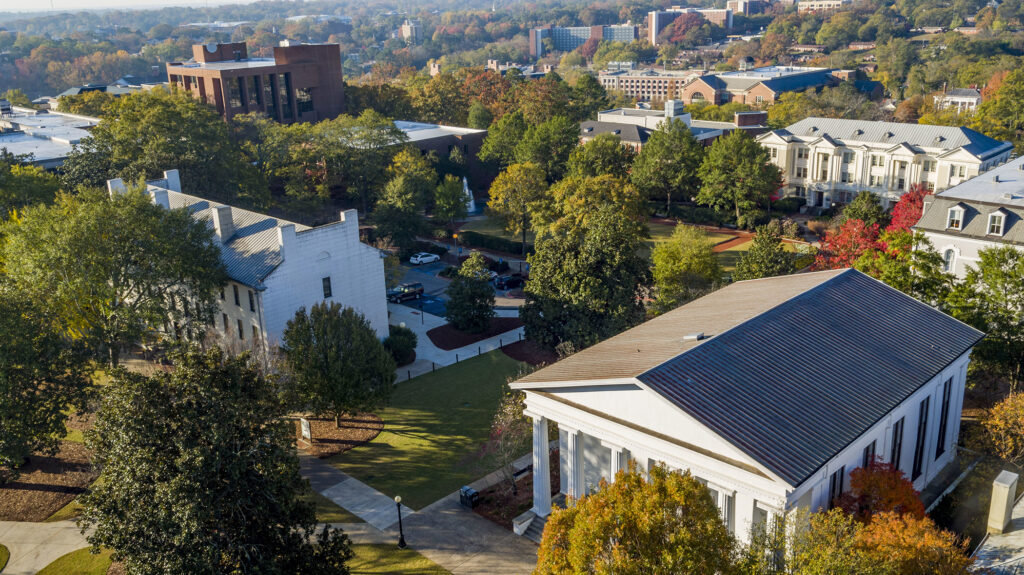The Office of University Architects began implementing a Historic Preservation Master Plan to document and maintain UGA buildings 50 years and older on all campuses and across the state in April 2018. The plan had its origins four years earlier, when President Jere W. Morehead charged a steering committee, led by then-Dean Dan Nadenicek of the College of Environment and Design, to develop an overall plan to guide the University’s stewardship of its historic resources. After several years of hard work by the committee—assisted by student researchers in conducting an extensive inventory of facilities across the state—the plan was presented to the University in a public forum in March 2018. It received the Outstanding Achievement Award from the Athens-Clarke Heritage Foundation in 2019 and the Excellence in Preservation Service Award from the Georgia Trust for Historic Preservation in 2020.
Columns recently spoke with Scott Messer, director of historic preservation in the Office of University Architects, and Gwynne Darden, associate vice president for facilities planning, about the goals of the plan, what has been accomplished and what the next steps are.
Columns: What qualifies a building to be part of the Historic Preservation Master Plan?
Messer: The Historic Preservation Master Plan covers a broad spectrum of buildings and landscapes. Generally, the plan focuses on buildings that are 50 years of age and possess integrity and significance. Structures that meet these designations are typically defined as “historic.” However, the plan also considers alterations to relatively new construction so that we don’t make design or material changes that will preclude their ability to be considered historic when they are 50 years old.
Columns: The process started with a historic resource inventory. How did that inventory help guide the Historic Preservation Master Plan?
Messer: The university was lacking a complete historic resource inventory of all its properties. We understood North Campus quite well, and to a lesser extent the bulk of the Athens campus. Many properties are quite remote from Athens, which extended the information collection and decision-making phase. To the surprise of many people who generally associate historic building preservation with North Campus, the preservation inventory process revealed that while there are 350 historic facilities in Clarke County, UGA actually has more historic facilities spread across the state—387 historic facilities in 20 other counties.
The inventory did two things. First, it put a great deal of information about every building at the fingertips of facilities managers to inform decision making. Second, it helped develop a preliminary assessment system that helps us evaluate integrity and significance early in the planning process. This allows us to be better informed earlier in the process to take the appropriate next steps.
Columns: What are the goals of the Historic Preservation Master Plan?
Messer: The primary goal of the plan is to implement a clear and transparent process that emphasizes the timely consideration of historic and archaeological resources in the early stages of the planning and design processes.
Columns: What progress has been made on the Historic Preservation Master Plan?
Messer: The “plan” is really an informed planning process that formally integrates historic preservation and archaeology into the planning and design process. It was delivered in an operational state. We have made substantial progress in making the plan more accessible to the university community: putting the plan online, explaining the methodology and operating procedures, and integrating the resource assessments with the campus interactive map so user access is point-and-click and complex processes are streamlined.
Also, we are working with the University Laboratory of Archaeology and the Georgia Archaeological Site Files to refine our process for conducting and inventorying archaeological investigations in a manner that generates consistent reporting and spatial information for future reference.
In terms of application to each of our historic facilities projects, the impact has been tremendous. More than 85 archaeological assessments have been completed, and more than 18 project-specific historic resources studies have been completed.
Columns: What has been learned from that progress?
Messer: The award-winning Historic Preservation Master Plan process that we’ve landed on is a very novel and effective approach to the management and protection of our historic resources. Presentations on the development of this useful plan have been well received by many other universities—especially those with large collections of resources.
Darden: With the completion of each project-specific archaeological assessment and historic resource study, not only does the current project benefit, but the additional in-depth information is also added to the Historic Preservation Master Plan database, which will further inform future projects.
Columns: What is the next project on the Historic Preservation Master Plan?
Messer: In 2021, we plan to continue reaching out to all of our university facility user groups across Georgia with in-person or virtual presentations to share information about the inventory, assessments and standard operating procedures.
Darden: We are nearing completion of a renovation feasibility study for the Holmes-Hunter Academic Building and are hopeful that the results of the study will lead to a planned renovation in the near future.
Often when a historic facility is considered on the Athens campus, a traditional style building comes to mind. However, UGA has many mid-century buildings. There are more than 300,000 gross square feet of historic buildings on Science Hill, and the first phase of a strategic renovation plan to modernize these research and instruction facilities is the planned interior renovation of the original portion of Building 1001 Chemistry Building.
Columns: What is left to do after that on the Historic Preservation Master Plan?
Messer: Our next implementation stage is to get the results of our archaeological investigations into the campus Geographic Information System with the goal of stitching them into a comprehensive map that allows us to quickly access information about areas where we are considering or planning ground-disturbing activities.
Darden: This is an active plan, and to keep it current, every 10 years the inventory will be updated with the next group of buildings that are between 40-50 years old.
Columns: Why was it important to develop a Historic Preservation Master Plan?
Messer: The Historic Preservation Master Plan addresses both historic resources (buildings and landscapes) and archaeological resources. The goals are twofold: first, to provide a clear and transparent process that ensures historic and archaeological resources are evaluated and considered in facilities planning; and second, to preserve the history of the University of Georgia.

